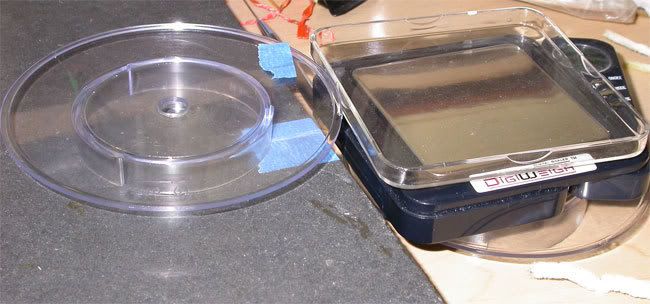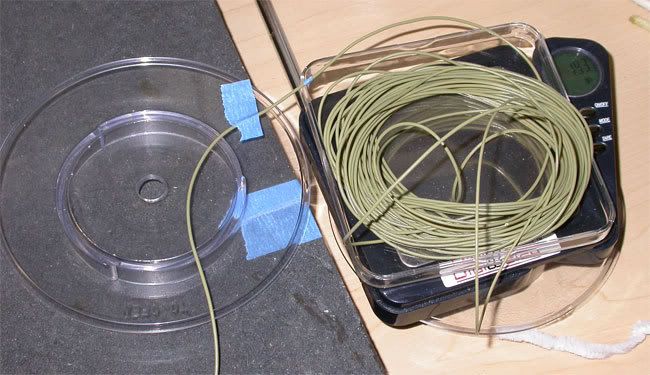Why would anyone want to weigh a fly line? To establish the line weight, of course. I've purchased many a used reel spooled with an unknown fly line. Some of these lines are perfectly good - once you know the line weight. And many NEW fly lines are not made to AFTMA standards (more later).
The AFTMA standards were developed in the early 60s to reduce the confusion of matching a fly line with a fly rod. The standards are simple. The first 30 feet of fly line, excluding the level tip section, is weighed. The weight in grains determines the line weight.
I use a cheap little digital scale for weighing fly lines. The scale is set to weigh directly in grains. I set up the scale with a small platform level with the pan of the scale.

I mark off the first 6-12" of fly line with a little tape (if I don't know the tip section length, I assume 6"). From that point, I measure an additional 30 feet of line and mark it with tape. I weigh the tip section of the line (and any attached leader) making sure the remainder of the fly line is supported by the platform. In the photo, there is a bodkin on the scale pan along with the tip section. These digital scales get a little flaky below 10 grains. Add something to the pan, note the weight, then add the tip section and do the math. This gives the weight of the tip section (usually 3-8 grains, this tip was 8 grains).

Next, I coil up the 30 feet of line and the tip section. I weigh this coil. Finally, I subtract the weight of the tip section. The weight is matched to the
AFFTA line standard chart. The combined weight of the line in the photo is 193 grains. After subtracting 8 grains for the tip section, I'm left with 185 grains, or a 7 weight line.

Things to note: Each line designation has a range of acceptable weights, i.e., 152-168 grains for a 6 weight line. Any line in that range is a 6 weight. A line outside of that range is not a 6 weight and should not be labeled as such. There are no provisions in the standard for "half" line weights. There are no provisions for determining the appropriate line weight for a fly rod.
I've found lines made before 1995 were made to the AFTMA standards. All double taper lines I've measured were right on the money. But out of a dozen, new, weight forward lines, only TWO lines met the standard. The remainder were heavy enough to almost make the next line designation. One DID make the next line designation!
Editorial: Line makers should either stick to the AFTMA standard or mark the line as something different. Jim Teeny labels his sinking lines with the actual weight of the sinking section in grains. Kudos for Jim! Rio sells non-standard fly lines, most notably the Grand and the Clouser. But Rio is very clear and detailed about their specifications. My measurements show Rio makes lines
exactly to their specs. Cortland marks some lines with "half size" designations. Scientific Anglers claims some lines are a "half" size heavy (sorry SA, I measure almost a full line weight hot). Orvis and Cabelas are clueless that their weight forward lines aren't close to AFTMA standards.
What to do? I buy double tapers and Rio lines that meet the AFTMA standards. Does it make a difference? Only in that I wish to know exactly what I am casting. The AFTMA standard was created for a reason and I will try to support it until a better standard is established.
Tom







